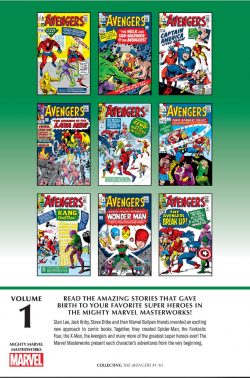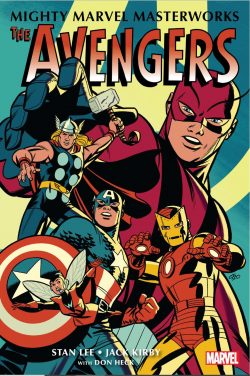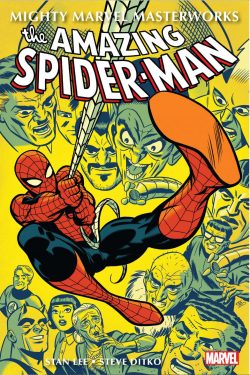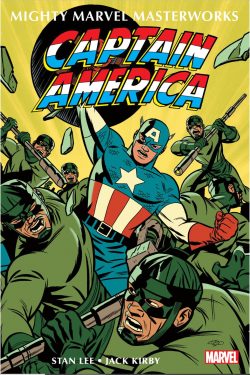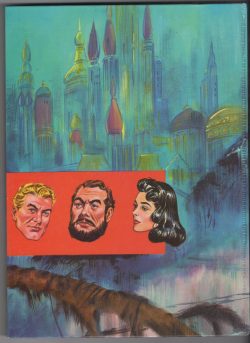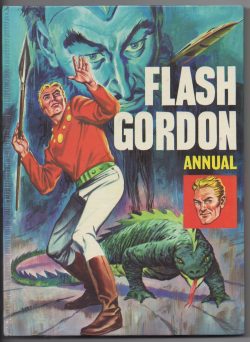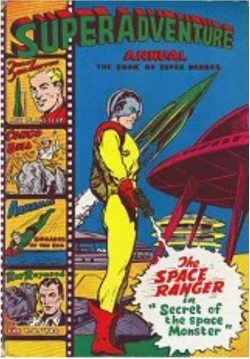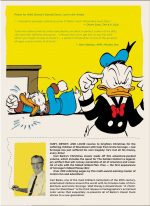
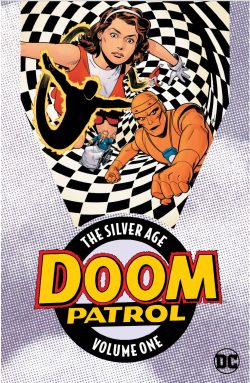
By Arnold Drake, Bob Haney, Bruno Premiani, Bob Brown & various (DC Comics)
ISBN: 978-1-4012-8111-3 (TPB/Digital edition)
1963 was the year when traditionally cautious comic book publishers finally realised that superheroes were back in a big way and began reviving and/or creating a host of costumed characters to battle outrageous menaces and dastardly villains.
Thus it was that the powers-that-be at National Comics decided that venerable adventure-mystery anthology title My Greatest Adventure would dip its toe in the waters with a radical take on the fad. Still, infamous for cautious publishing, they introduced a startling squad of champions with its thematic roots still firmly planted in the B-movie monster films of the era that had not-so-subtly informed the parent comic.
No traditional team of masked adventurers, this cast comprised a robot, a mummy and an occasional 50-foot woman, who joined forces with and were guided by a vivid, brusque, domineering, crippled mad scientist to fight injustice in a whole new way…
Covering June 1963 to May 1965, this stunning compilation collects the earliest exploits of the “Fabulous Freaks”, gathered from My Greatest Adventure #80-85 and thereafter issues #86-95 of the rapidly renamed title, once overwhelming reader response compelled editor Murray Boltinoff to change it to the Doom Patrol.
These dramas were especially enhanced and elevated by the drawing skills of Italian cartoonist and classicist artist Giordano Bruno Premiani, whose highly detailed, subtly humanistic illustration made even the strangest situation dauntingly authentic and grittily believable.
Eponymous premier tale ‘The Doom Patrol’ was co-scripted by Arnold Drake and Bob Haney, depicting how a mysterious wheelchair-bound scientist summons three outcasts to his home through the promise of changing their miserable lives forever…
Competitive car racer and professional daredevil Cliff Steele had died in a horrific pile up, but his undamaged brain had been transplanted into a fantastic mechanical body. Test pilot Larry Trainor had been trapped in an experimental stratospheric plane and become permanently irradiated by stratospheric radiation, with the dubious benefit of gaining a semi-sentient energy avatar which would escape his body to perform incredible feats for up to a minute at a time. To pass safely amongst men Trainor had to constantly wrap himself in unique radiation-proof bandages…
Former movie star Rita Farr was exposed to mysterious gases which gave her the terrifying, unpredictable and, at first, uncontrolled ability to shrink or grow to incredible sizes.
The outcasts were brought together by brilliant but enigmatic Renaissance Man The Chief, who sought to mould the solitary misfits into a force for good. He quickly proved his point when a mad bomber attempted to blow up the city docks. The surly savant directed the trio of strangers in defusing it and no sooner had the misfits realised their true worth than they were on their first mission…
Second chapter ‘The Challenge of the Timeless Commander’, sees an implausibly ancient despot seeking to seize a fallen alien vessel: intent on turning its extraterrestrial secrets into weapons of world conquest, culminating in ‘The Deadly Duel with General Immortus’ which saw the Doom Patrol defeat the old devil and thereafter dedicate their lives to saving humanity from all threats.
My Greatest Adventure #81 featured ‘The Nightmare Maker’, combining everyday disaster response – saving a damaged submarine – with a nationwide plague of monsters. Stuck at base, The Chief monitors missions by means of a TV camera attached to Robotman/Steele’s chest, and quickly deduces the uncanny secret of the beasts and their war criminal creator Josef Kreutz…
Solely scripted by Drake, a devious espionage ploy outs the Chief – or at least his image, if not name – in #82’s ‘Three Against the Earth!’, leading the team to believe Rita is a traitor. When the cabal of millionaires actually behind the scheme are exposed as an alien advance guard who assumed the wheelchair-bound leader to be a rival invader, the inevitable showdown nearly costs Cliff what remains of his life…
In #83, ‘The Night Negative Man Went Berserk!’ spotlights the living mummy as a radio astronomy experiment interrupts the Negative Man’s return to Trainor’s body: pitching the pilot into a coma and sending the ebony energy being on a global spree of destruction. Calamity piles upon calamity when crooks steal the military equipment constructed to destroy the radio-energy creature and only desperate improvisation by Cliff and Rita allows avatar and host to reunite…
Issue #84 heralded ‘The Return of General Immortus’ as ancient Babylonian artefacts lead the squad to the eternal malefactor, only to have the wily warrior turn the tables and take control of Robotman. Even though his comrades soon save him, Immortus escapes with the greatest treasures of all time…
My Greatest Adventure #85 was the last issue, featuring ‘The Furies from 4,000 Miles Below’: monstrous subterranean horrors fuelled by nuclear forces. Despite having tricked Elasti-Girl into resuming her Hollywood career, the paternalistic heroes are pretty grateful when she turns up to save them all from radioactive incineration…
An unqualified success, the comic book transformed seamlessly into The Doom Patrol with #86 and celebrated by introducing ‘The Brotherhood of Evil’: an assemblage of international terrorist super-criminals led by French genius-in-a-jar The Brain. He was backed up by his greatest creation, a super-intelligent talking gorilla dubbed Monsieur Mallah.
The diametrically opposed teams first cross swords after brotherhood applicant Mr. Morden steals Rog, a giant robot the Chief constructed for the US military…
DP #87 revealed ‘The Terrible Secret of Negative Man’ after Brotherhood femme fatale Madame Rouge attempts to seduce Larry. When the Brain’s unstoppable mechanical army invades the city, Trainor is forced to remove his bandages and allow his lethal radiations to disrupt their transmissions…
An occasional series of short solo adventures kicked off in this issue with ‘Robotman Fights Alone’. Here Cliff is dispatched to a Pacific island in search of an escaped killer, only to walk into a devastating series of WWII Japanese booby-traps…
All mysteries surrounding the team’s leader are finally revealed in issue #88 with ‘The Incredible Origin of the Chief’: a blistering drama telling how brilliant but impoverished student Niles Caulder suddenly received unlimited funding from an anonymous patron interested in his researches on extending life.
Curiosity drove Caulder to track down his benefactor and he was horrified to discover the money came from the head of a criminal syndicate who claimed to be eons old…
Immortus had long ago consumed a potion which extended his life and wanted the student to recreate it since the years were finally catching up. To insure Caulder’s full cooperation, the General had a bomb inserted in the researcher’s chest and powered by his heartbeat…
After building a robot surgeon, Caulder tricked Immortus into shooting him, determined to thwart the monster at all costs. Once clinically dead, his Ra-2 doctor-bot removed the now-inert explosive and revived the bold scientist. Tragically, the trusty mechanoid had been too slow and Caulder lost the use of his legs forever…
Undaunted, ‘The Man Who Lived Twice’ destroyed all his research and went into hiding for years, with Immortus utterly unaware that Caulder had actually succeeded in the task which had stymied history’s greatest doctors and biologists…
Now, under the alias of super-thief The Baron, Immortus captures the Doom Patrol and demands a final confrontation with the Chief. Luckily, the wheelchair-locked inventor is not only a biologist and robotics genius but also adept at constructing concealed weapons…
In DP #89 the team tackle a duplicitous scientist who devises a means to transform himself into ‘The Animal-Vegetable-Mineral Menace’ before ‘The Private War of Elasti-Girl’ finds the Maid of Many Sizes using unsuspected detective skills to track down a missing soldier and reunite him with his adopted son.
‘The Enemy within the Doom Patrol’ sees shape-shifting Madame Rouge infiltrate the team and turn them against each other whilst issue #91 introduces multi-millionaire Steve Dayton.
Used to getting whatever he wants, he creates a superhero persona solely to woo and wed Rita Farr. With such ambiguous motivations ‘Mento – the Man who Split the Doom Patrol’ was a radical character for the times, but at least his psycho-kinetic helmet proved a big help in defeating the plastic robots of grotesque alien invader Garguax…
DP #92 tasks the team with a temporal terrorist in ‘The Sinister Secret of Dr. Tyme’ and features abrasive Mento again saving the day, after which ‘Showdown on Nightmare Road’ in #93 features The Brain’s latest monstrous scheme. This results in the evil genius being transplanted inside Robotman’s skull whilst poor Cliff is dumped into a horrific beast, until the Chief out-plays the French Fiend at his own game…
Creature-feature veteran Bob Brown stepped in to illustrate #94’s lead tale ‘The Nightmare Fighters’ as an eastern mystic’s uncanny abilities are swiftly debunked by solid American science. Premiani returned to render back-up solo-feature ‘The Chief …Stands Alone’ wherein Caulder eschews his deputies’ aid to bring down bird-themed villain The Claw with a mixture of wit, nerve and weaponised wheelchair.
This initial outing concludes with The Chief’s disastrous effort to cure Rita and Larry (DP #95), resulting in switched powers and the ‘Menace of the Turnabout Heroes’, so naturally that would be the very moment the Animal-Vegetable-Mineral Man picks for a return bout…
Although as kids we all happily suspended disbelief and bought into the fanciful antics of the myriad masked heroes available, somehow the exploits of the Doom Patrol – and their surprisingly synchronistic Marvel counterparts The X-Men (freaks, outcasts, wheelchair geniuses, both debuting in the summer of 1963 – so happy shared 60th folks!) – always seemed just a bit more “real” and plausible than the usual caped and costumed crowd.
With the edge of time and experience on my side it’s obvious just how incredibly mature and hardcore Drake, Haney & Premian’s take on superheroes actually was. These superbly engaging, frantically fun and breathtakingly beautiful tales should rightfully rank amongst the finest Fights ‘n’ Tights tales ever told. Moreover, you should definitely own them, so go do that now.
© 1963, 1964, 1965, 2018 DC Comics, Inc. All Rights Reserved.

